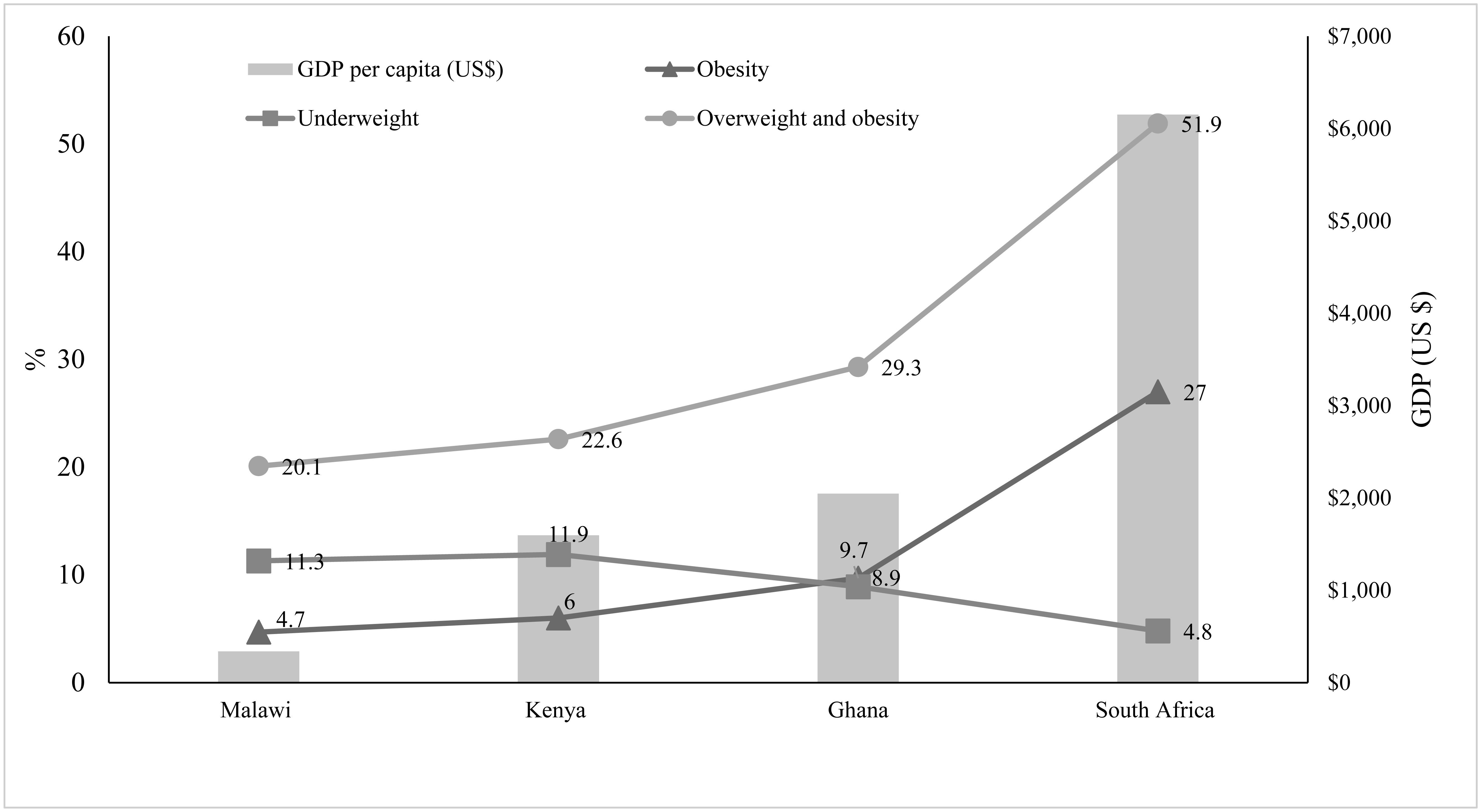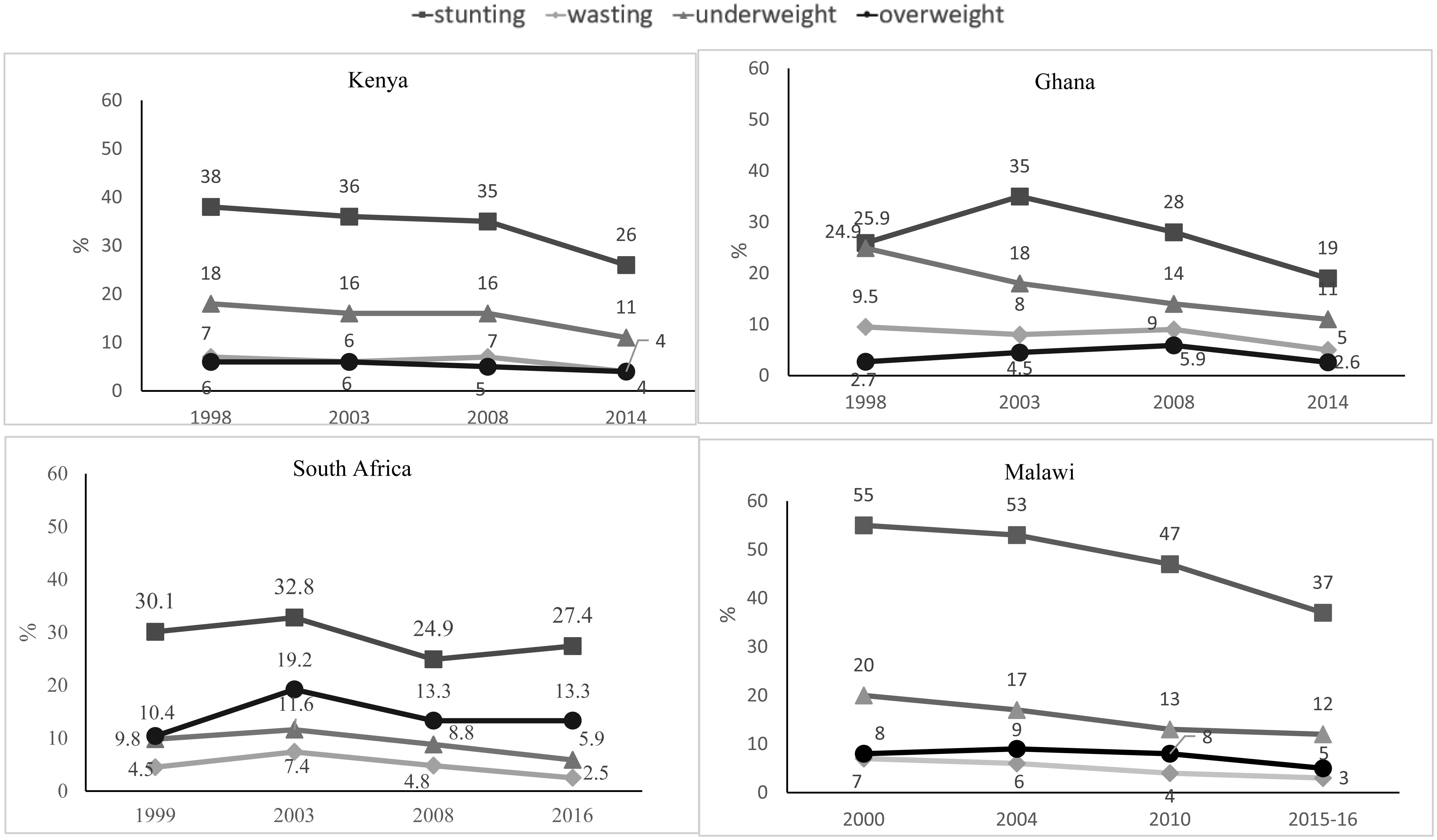| 1.
|
Amare Molla Dinku, Tefera Chane Mekonnen, Getachew Shumye Adilu,
Child dietary diversity and food (in)security as a potential correlate of child anthropometric indices in the context of urban food system in the cases of north-central Ethiopia,
2020,
39,
2072-1315,
10.1186/s41043-020-00219-6
|
|
| 2.
|
Amy E. Mendham, Lillemor Lundin-Olsson, Julia H. Goedecke, Lisa K. Micklesfield, Dirk L. Christensen, Iain J. Gallagher, Kathryn H. Myburgh, Feyisayo A. Odunitan-Wayas, Estelle V. Lambert, Sebastiana Kalula, Angus M. Hunter, Naomi E. Brooks,
Sarcopenic Obesity in Africa: A Call for Diagnostic Methods and Appropriate Interventions,
2021,
8,
2296-861X,
10.3389/fnut.2021.661170
|
|
| 3.
|
Paola Caroline L. Leocádio, Synara C. Lopes, Ronaldo P. Dias, Jacqueline I. Alvarez-Leite, Richard L. Guerrant, João O. Malva, Reinaldo B. Oriá,
The Transition From Undernutrition to Overnutrition Under Adverse Environments and Poverty: The Risk for Chronic Diseases,
2021,
8,
2296-861X,
10.3389/fnut.2021.676044
|
|
| 4.
|
Sherifath Mama Chabi, Nadia Fanou Fogny, Eunice Nago Koukoubou, Axel Egbakotan, Yrence Amoussou Lokossou, S. Bourekkadi, H. Hami, A. Mokhtari, K. Slimani, A. Soulaymani,
Perception of secondary school adolescent girls on their own diet and health status in urban Benin,
2021,
319,
2267-1242,
01098,
10.1051/e3sconf/202131901098
|
|
| 5.
|
Patricia Arnaiz, Ivan Müller, Harald Seelig, Markus Gerber, Jacob Bosma, Danielle Dolley, Larissa Adams, Jan Degen, Stefanie Gall, Nandi Joubert, Madeleine Nienaber, Siphesihle Nqweniso, Ann Aerts, Peter Steinmann, Rosa du Randt, Cheryl Walter, Jürg Utzinger, Uwe Pühse,
Practice Change Needed for the Identification of Pediatric Hypertension in Marginalized Populations: An Example From South Africa,
2022,
10,
2296-2360,
10.3389/fped.2022.877431
|
|
| 6.
|
Qing Yang, Jinlian Yang, Liming Zheng, Wei Song, Lilan Yi,
Impact of Home Parenting Environment on Cognitive and Psychomotor Development in Children Under 5 Years Old: A Meta-Analysis,
2021,
9,
2296-2360,
10.3389/fped.2021.658094
|
|
| 7.
|
Danielle Dolley, Rosa Du Randt, Uwe Pühse, Markus Gerber, Jacob Bosma, Ann Aerts, Larissa Adams, Patricia Arnaiz, Nandi Joubert, Ivan Müller, Siphesihle Nqweniso, Harald Seelig, Peter Steinmann, Jürg Utzinger, Cheryl Walter,
Relationship between Body Mass Index and Physical Activity among Children from Low-Income Communities in Gqeberha, South Africa: A Cross-Sectional Study,
2023,
20,
1660-4601,
1428,
10.3390/ijerph20021428
|
|
| 8.
|
Xihua Lin, Hong Li,
Obesity: Epidemiology, Pathophysiology, and Therapeutics,
2021,
12,
1664-2392,
10.3389/fendo.2021.706978
|
|
| 9.
|
Daniel O. Mensah, Godwin Yeboah, Michael Batame, Rob Lillywhite, Oyinlola Oyebode,
Type, density, and healthiness of food-outlets in a university foodscape: a geographical mapping and characterisation of food resources in a Ghanaian university campus,
2022,
22,
1471-2458,
10.1186/s12889-022-14266-7
|
|
| 10.
|
Sabri Bromage, Yiwen Zhang, Michelle D Holmes, Sonia E Sachs, Jessica Fanzo, Roseline Remans, Jeffrey D Sachs, Carolina Batis, Shilpa N Bhupathiraju, Teresa T Fung, Yanping Li, Meir J Stampfer, Megan Deitchler, Walter C Willett, Wafaie W Fawzi,
The Global Diet Quality Score Is Inversely Associated with Nutrient Inadequacy, Low Midupper Arm Circumference, and Anemia in Rural Adults in Ten Sub-Saharan African Countries,
2021,
151,
00223166,
S119,
10.1093/jn/nxab161
|
|
| 11.
|
Elizabeth Olatunji, Charles Obonyo, Pamela Wadende, Vincent Were, Rosemary Musuva, Charles Lwanga, Eleanor Turner-Moss, Matthew Pearce, Ebele R. I. Mogo, Oliver Francis, Louise Foley,
Cross-Sectional Association of Food Source with Food Insecurity, Dietary Diversity and Body Mass Index in Western Kenya,
2021,
14,
2072-6643,
121,
10.3390/nu14010121
|
|
| 12.
|
Tiange Liu, Sherryl Broverman, Eve S. Puffer, Daniel A. Zaltz, Andrew L. Thorne-Lyman, Sara E. Benjamin-Neelon,
Dietary Diversity and Dietary Patterns in School-Aged Children in Western Kenya: A Latent Class Analysis,
2022,
19,
1660-4601,
9130,
10.3390/ijerph19159130
|
|
| 13.
|
A. Bose, N. Mondal, J. Sen,
Household Levels of Double Burden of Malnutrition in Low–Middle-income Countries: A Review,
2022,
71,
2277-436X,
125,
10.1177/2277436X211043628
|
|
| 14.
|
Lemma Getacher, Beyene Wondafrash Ademe, Tefera Belachew,
Lived Experience and Perceptions of Adolescents on Prevention, Causes and Consequences of Double Burden of Malnutrition in Debre Berhan City, Ethiopia: A Qualitative Study,
2023,
Volume 16,
1178-7074,
337,
10.2147/IJGM.S398330
|
|
| 15.
|
Kibrom T. Sibhatu, Aslihan Arslan, Emanuele Zucchini,
The effect of agricultural programs on dietary diversity and food security: Insights from the smallholder productivity promotion program in Zambia,
2022,
113,
03069192,
102268,
10.1016/j.foodpol.2022.102268
|
|
| 16.
|
Olufunke A. Alaba, Plaxcedes Chiwire, Aggrey Siya, Oluremi A. Saliu, Karen Nhakaniso, Emmanuella Nzeribe, Denis Okova, Akim Tafadzwa Lukwa,
Socio-Economic Inequalities in the Double Burden of Malnutrition among under-Five Children: Evidence from 10 Selected Sub-Saharan African Countries,
2023,
20,
1660-4601,
5489,
10.3390/ijerph20085489
|
|
| 17.
|
Solomon Mekonnen, Dereje Birhanu, Yonatan Menber, Zenebe Abebe Gebreegziabher, Mahider Awoke Belay,
Double burden of malnutrition and associated factors among mother–child pairs at household level in Bahir Dar City, Northwest Ethiopia: community based cross-sectional study design,
2024,
11,
2296-861X,
10.3389/fnut.2024.1340382
|
|
| 18.
|
Arnol Bowo-Ngandji, Sebastien Kenmoe, Jean Thierry Ebogo-Belobo, Raoul Kenfack-Momo, Guy Roussel Takuissu, Cyprien Kengne-Ndé, Donatien Serge Mbaga, Serges Tchatchouang, Josiane Kenfack-Zanguim, Robertine Lontuo Fogang, Elisabeth Zeuko’o Menkem, Juliette Laure Ndzie Ondigui, Ginette Irma Kame-Ngasse, Jeannette Nina Magoudjou-Pekam, Maxwell Wandji Nguedjo, Jean Paul Assam Assam, Damaris Enyegue Mandob, Judith Laure Ngondi, Ozra Tabatabaei-Malazy,
Prevalence of the metabolic syndrome in African populations: A systematic review and meta-analysis,
2023,
18,
1932-6203,
e0289155,
10.1371/journal.pone.0289155
|
|
| 19.
|
Akim Tafadzwa Lukwa, Plaxcedes Chiwire, Folahanmi Tomiwa Akinsolu, Denis Okova, Charles Hongoro,
Double burden of malnutrition among women and children in Zimbabwe: a pooled logistic regression and Oaxaca-Blinder decomposition analysis,
2024,
12,
2296-2565,
10.3389/fpubh.2024.1451898
|
|
| 20.
|
Hester Vermeulen, Ferdinand Meyer, Hettie C. Schönfeldt,
A basic healthy food basket approach to evaluate the affordability of healthy eating in South Africa and Kenya,
2023,
7,
2571-581X,
10.3389/fsufs.2023.1181683
|
|
| 21.
|
Alemu Belayneh, Legese Chelkeba, Firehiwot Amare, Henok Fisseha, Senbeta Guteta Abdissa, Mirgissa Kaba, Shivani A. Patel, Mohammed K. Ali,
Investigation of non-communicable diseases prevalence, patterns, and patient outcomes in hospitalized populations: a prospective observational study in three tertiary hospitals,
2024,
43,
2072-1315,
10.1186/s41043-024-00599-z
|
|
| 22.
|
Akim Tafadzwa Lukwa, Feyisayo A. Wayas, Estelle Victoria Lambert, Olufunke Alaba,
Stakeholder mapping to explore social and economic capital of Rotating Savings and Credit Associations (ROSCAs) to increase demand for and access to healthy food,
2024,
8,
2571-581X,
10.3389/fsufs.2024.1301578
|
|
| 23.
|
2021,
9781119717515,
191,
10.1002/9781119717577.ch6
|
|
| 24.
|
Amynah Janmohamed, Melissa M. Baker, David Doledec, Fatou Ndiaye, Ahmenan Claude Liliane Konan, Amoakon Leonce, Koffi Landry Kouadio, Maguette Beye, Delphine Danboyi, Theresia J. Jumbe, Alex Ndjebayi, Caleb Ombati, Benjamin K. Njenga, Romance Dissieka,
Dietary Quality and Associated Factors among Women of Reproductive Age in Six Sub-Saharan African Countries,
2024,
16,
2072-6643,
1115,
10.3390/nu16081115
|
|
| 25.
|
William A. Russel, Jim Perry, Claire Bonzani, Amanda Dontino, Zeleke Mekonnen, Ahmet Ay, Bineyam Taye,
Feature selection and association rule learning identify risk factors of malnutrition among Ethiopian schoolchildren,
2023,
3,
2674-1199,
10.3389/fepid.2023.1150619
|
|
| 26.
|
Kimberly E. Johnson, Julia Hayes, Patricia Davidson, Chiwoneso B. Tinago, Geoffrey Anguyo,
‘Never cry for food’: food security, poverty, and recurring themes in news media regarding rabbit farming in East Africa,
2024,
39,
1742-1705,
10.1017/S1742170523000480
|
|
| 27.
|
Mustapha Amoadu, Susanna Aba Abraham, Abdul Karim Adams, William Akoto-Buabeng, Paul Obeng, John Elvis Hagan,
Risk Factors of Malnutrition among In-School Children and Adolescents in Developing Countries: A Scoping Review,
2024,
11,
2227-9067,
476,
10.3390/children11040476
|
|
| 28.
|
Teresia Mbogori, James Muriuki,
Demographic and Social-Economic Determinants of Malnutrition among Children (0-23 Months Old) in Kenya,
2021,
10,
1929-4247,
80,
10.6000/1929-4247.2021.10.03.1
|
|
| 29.
|
Adusei Bofa, Temesgen Zewotir,
Key predictors of food security and nutrition in Africa: a spatio-temporal model-based study,
2024,
24,
1471-2458,
10.1186/s12889-024-18368-2
|
|
| 30.
|
Djiba Diakité, Sidikiba Sidibé, Fassou Kolié, Facely Camara, Djiki Mounir Camara, Mory Kourouma, Alexandre Délamou,
Prevalence and factors associated with the coexistence of overweight/obesity and anaemia among women of reproductive age in Guinea,
2023,
26,
1368-9800,
2748,
10.1017/S1368980023002197
|
|
| 31.
|
Mihret Melese, Dereje Esubalew, Asmamaw Malede, Tsegaye Adane Birhan, Jember Azanaw,
Environmental Predictors of Undernutrition Among Under-5 Children at Dabat District Health Facilities, Northwest Ethiopia, 2023,
2024,
18,
1178-6302,
10.1177/11786302241252735
|
|
| 32.
|
Tilahun Tewabe Alamnia, Ginny M. Sargent, Matthew Kelly,
Dietary patterns and associations with metabolic risk factors for non-communicable disease,
2023,
13,
2045-2322,
10.1038/s41598-023-47548-0
|
|
| 33.
|
Winnie Chepng’etich Sambu, Fiorella Picchioni, Sara Stevano, Emmanuel A. Codjoe, Paul Kwame Nkegbe, Christopher Turner,
Food systems thinking unpacked: a scoping review on industrial diets among adolescents in Ghana,
2024,
16,
1876-4517,
79,
10.1007/s12571-023-01408-x
|
|
| 34.
|
Umesh Velu, Anshul Singh, Roselin Nittala, Johnny Yang, Srinivasan Vijayakumar, Chanukya Cherukuri, Gregory R Vance, John D Salvemini, Bradley F Hathaway, Camille Grady, Jeffrey A Roux, Shirley Lewis,
Precision Population Cancer Medicine in Brain Tumors: A Potential Roadmap to Improve Outcomes and Strategize the Steps to Bring Interdisciplinary Interventions,
2024,
2168-8184,
10.7759/cureus.71305
|
|
| 35.
|
Nomzamo N. Magano, Hely Tuorila, Henrietta L. De Kock,
Food choice drivers at varying income levels in an emerging economy,
2023,
189,
01956663,
107001,
10.1016/j.appet.2023.107001
|
|
| 36.
|
K. Amlaev, M. Atoeva, G. Zharilkasynova,
Obesity as a medical and social problem,
2024,
25877305,
34,
10.29296/25877305-2024-11-06
|
|
| 37.
|
Tom X Hackbarth, Julian D. May, Sinoxolo Magaya, Peter H Verburg,
Food systems modelling to evaluate interventions for food and nutrition security in an African urban context,
2024,
1876-4517,
10.1007/s12571-024-01502-8
|
|
| 38.
|
Taddese A Zerfu, Amare A Tareke, Sibhatu Biadgilign,
Redefining health priorities: Sub-Saharan Africa’s new frontier in disease burden,
2024,
14,
2047-2978,
10.7189/jogh.14.03049
|
|
| 39.
|
Alexandre Tuyishimire, Jingjing Yin, Jianyi Lin, Mingliang Liu, Jian Tao, Fabien Muhirwa,
Can adopting the EAT-Lancet diet bring synergistic benefits in nutrition and sustainability? Evidence from African countries,
2025,
215,
09213449,
108173,
10.1016/j.resconrec.2025.108173
|
|
| 40.
|
Gugulethu T. Moyo, Burcu Tepekule, Leolin Katsidzira, Martin J. Blaser, C. Jessica E. Metcalf,
Getting ahead of human-associated microbial decline in Africa: the urgency of sampling in light of epidemiological transition,
2025,
0966842X,
10.1016/j.tim.2025.01.004
|
|
| 41.
|
Bereket Gebremichael, Admas Abera, Sibhatu Biadigilign, Kaleab Baye, Shao Jia Zhou, Demewoz Haile,
Double burden of malnutrition among under-five children in Eastern and Southern African countries,
2025,
15,
2045-2322,
10.1038/s41598-025-87144-y
|
|
| 42.
|
Simbarashe Kasanzu, Joconiah Chirenda, Anesu Marume,
Diet and sociodemographic predictors of the double burden of malnutrition in urban Zimbabwe,
2025,
17,
2071-2936,
10.4102/phcfm.v17i1.4834
|
|









 DownLoad:
DownLoad:






